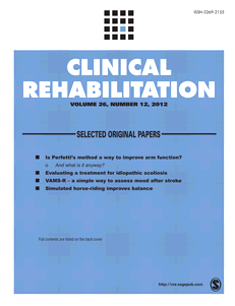
PHYSICAL THERAPY & REHAB
No difference between pulsed radiofrequency and TENS for shoulder pain
This report has been verified
by one or more authors of the
original publication.
Clin Rehabil. 2010 Nov;24(11):1000-8
40 participants between the ages of 18 and 80, who had been experiencing shoulder pain for at least three months were randomly assigned into 1 of 2 groups, a pulsed radiofrequency or transcutaneous electrical nerve stimulation group, to compare the effectiveness of each method for the treatment of shoulder pain. Results of the study indicated that both treatments were effective in the management of shoulder pain, but there were no significant differences between two treatments in terms of VAS, range of motion, Shoulder Pain and Disability Index (except total score), SF36 sub scores, or paracetamol consumption at any time point. The only difference between the two groups occurred in the first week of treatment, where results demonstrated that pulsed radiofrequency treatment lead to a significantly greater Shoulder Pain and disability Index total score.
Unlock the full ACE Report
You have access to {0} free articles per month.Click below to unlock and view this {1}
Unlock NowCritical appraisals of the latest, high-impact randomized controlled trials and systematic reviews in orthopaedics
Access to OrthoEvidence podcast content, including collaborations with the Journal of Bone and Joint Surgery, interviews with internationally recognized surgeons, and roundtable discussions on orthopaedic news and topics
Subscription to The Pulse, a twice-weekly evidence-based newsletter designed to help you make better clinical decisions
Exclusive access to original content articles, including in-house systematic reviews, and articles on health research methods and hot orthopaedic topics
Or upgrade today and gain access to all OrthoEvidence content for just $1.99 per week.
Already have an account? Log in


Subscribe to "The Pulse"
Evidence-Based Orthopaedics direct to your inbox.
{0} of {1} free articles
Become an OrthoEvidence Premium Member. Expand your perspective with high-quality evidence.
Upgrade Now













































































